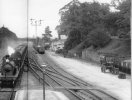MaxB
Member
- Joined
- 28 Jan 2017
- Messages
- 38
I have received an email which says "The railway coal wagons would come in onto the sidings and unload coal from the coal wagons and apparently the coal wagons had a metal wheel on the wagon which you would turn and tip the coal wagon sideways to empty the coal out. Then the coal would be collected by the coalman who would put the coal in 100 cwt sacks and would put it on his horse drawn coal cart to deliver to his customers for their coal fires in their homes. The coal wagons were pushed backwards into the sidings at Bromley South by a steam powered shunter."
I attach a picture from 1921. So far as I know only ordinary 16t side loading wagons were used (or existed). Does anyone have any ideas what the emailer is referring to? I believe it to be a yarn but has the wagon in the middle got some sort of central handle - maybe you know more? Help appreciated.
So far as I know only ordinary 16t side loading wagons were used (or existed). Does anyone have any ideas what the emailer is referring to? I believe it to be a yarn but has the wagon in the middle got some sort of central handle - maybe you know more? Help appreciated.
I attach a picture from 1921.
 So far as I know only ordinary 16t side loading wagons were used (or existed). Does anyone have any ideas what the emailer is referring to? I believe it to be a yarn but has the wagon in the middle got some sort of central handle - maybe you know more? Help appreciated.
So far as I know only ordinary 16t side loading wagons were used (or existed). Does anyone have any ideas what the emailer is referring to? I believe it to be a yarn but has the wagon in the middle got some sort of central handle - maybe you know more? Help appreciated.